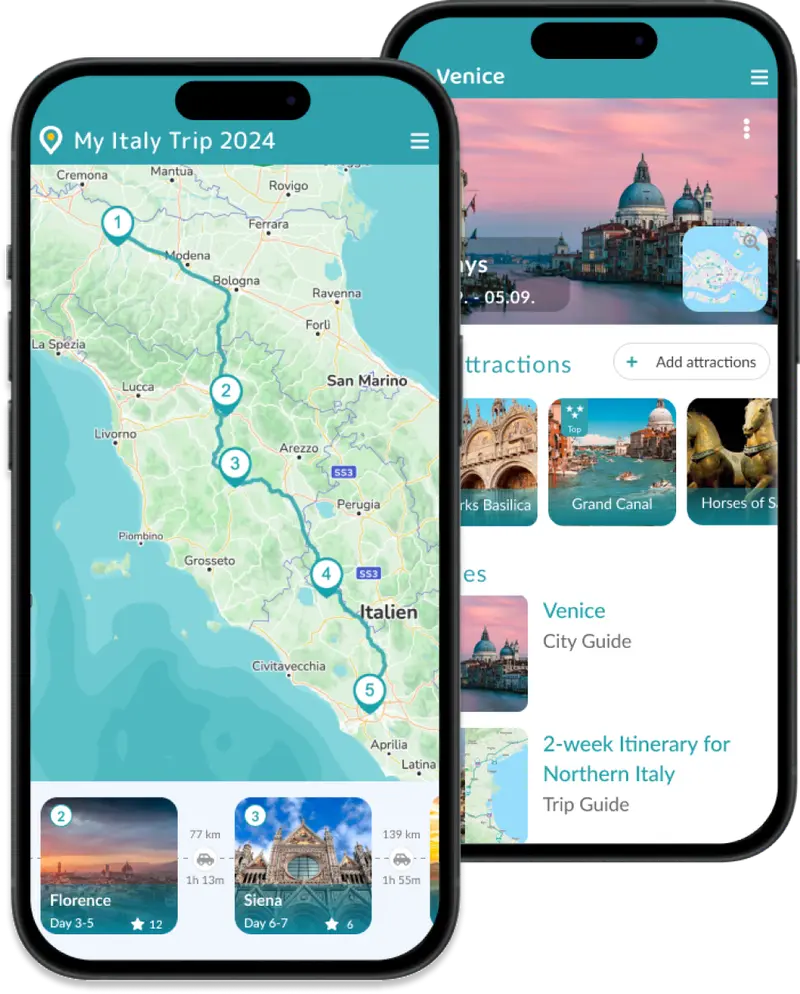Matera, the remarkable city of caves, justly earns its status as a World Heritage Site. Boasting a history that spans over 7,000 years, it ranks among the oldest continuously inhabited cities on Earth. Once regarded as Italy’s disgrace, Matera now captivates visitors worldwide with its intricate maze of limestone churches and cave dwellings.
Wander through the , where cave homes, churches, and boutique hotels are seamlessly embedded into the rocky landscape. As the sun dips below the horizon, the city's stone facades glow with a warm, ethereal light. Whether it's wandering through the labyrinthine streets, enjoying the sunset from the , or savoring the Matera bread, a visit to Matera is a plunge into a striking past that continues to enchant and inspire.
Top Highlights of Matera










Inspiration
Travel Info
Best time to visit
Matera is best visited from April to October. During these months, the weather is pleasantly warm, and the city buzzes with outdoor activities.
Spring
From April to May Matera is in full bloom, with comfortable temperatures averaging 15°C to 18°C. Spring season is ideal for exploring the city's Sassi and outdoor attractions without the summer crowds.
Summer
Visiting in June and August, promises hot and dry weather. While this period offers long, sunny days perfect for sightseeing, it's also when Matera sees the most tourists. To avoid the sweltering heat, start your tour early in the morning or in the late afternoon. During midday take a break or plan an indoor visit in one of the caves and churches.
Autumn
September and October offer a beautiful backdrop of changing colors and a respite from the summer heat, with temperatures ranging from mild to pleasantly warm.
How to get to Matera
By Plane
The closest airport to Matera is the airport in Bari, located about 65 km away. Once you've landed, the easiest way to reach Matera is by car or bus.
By Car
Since visiting Matera is often combined with a Puglia road trip, a rental car is a popular option. From the Bari Airport you would need around 50 min (SS 96 and SS 99 highways).
Travelers coming from the west, say from Naples, can take the A3 and E847 highways.
Matera's historic center is largely a ZTL zone, restricting vehicle access. Visitors are advised to park in the modern part of Matera.
By Bus
By bus it takes around 1 hour and 15 minutes from Bari and is both the fastest and most economical option, costing about €4–7.
Fancy a roadtrip?
Be inspired by our hand-picked road trips.

Specialities
What to Drink

Enjoy a cocktail in the Zipa Cafe, a unique cave bar. With its cozy atmosphere and handcrafted drinks, it's the perfect spot to relax after a day of exploring.
What to Eat
Matera offers traditional dishes rich in flavor:
- Cavatelli Materani: Small, handmade pasta shells served with a hearty tomato-based sauce, often topped with breadcrumbs
- Pane di Matera: A traditional bread made from durum wheat flour, known for its crispy crust and soft interior, shaped distinctively and baked in wood-burning ovens .
- Peperoni cruschi: Sun-dried red peppers that are then deep-fried, offering a unique aroma and flavor. They're a delicious addition to salads or as a pasta topping.
- Capocollo di Martina Franca: A seasoned cured meat from the neck of the pig, originating from Martina Franca, and served thinly sliced.
- Lucanica Sausage: Flavorful sausages made from a mix of pork, fat, and spices, suitable for grilling, roasting, or adding to pasta dishes.
History
Matera, a city with roots stretching back to the Palaeolithic era (10th millennium BC), is one of the world's oldest continuously inhabited settlements. The Sassi of Matera, a series of cave dwellings carved into limestone, represent the heart of the city's ancient history. These caves, initially natural, were expanded and developed over millennia. Matera's strategic location on a ravine's edge, served by two natural streams, facilitated its early development and defense.
The city's complex history saw it under the rule of Romans, Lombards, Arabs, Byzantines, Swabians, Angevins, Aragonese, and Bourbons before its integration into the modern Italian state. Founded by the Romans in 251 BC as Matheola, Matera was later occupied by the Lombards, becoming part of the Duchy of Benevento in AD 664.
By the 1950s, Matera's Sassi were synonymous with poverty. Over half of the city's population lived in these cave dwellings, facing dire conditions without access to modern amenities, leading to high infant mortality rates and widespread malnutrition. This visibility of poverty prompted government-led relocations and efforts to improve living conditions in the latter half of the 20th century.
The revitalization efforts in the latter half of the 20th century transformed Matera from a symbol of poverty into a UNESCO World Heritage Site, celebrated for its unique cultural landscape and historical significance. In 2019, Matera was named a European Capital of Culture, highlighting its remarkable journey from ancient settlement to a beacon of cultural and historical preservation. Due to its unique looks, Matera was also chosen as a film location for Mel Gibson's "Passion of Christ" and the latest Bond film.





